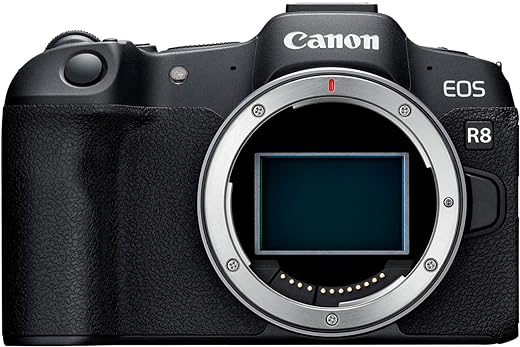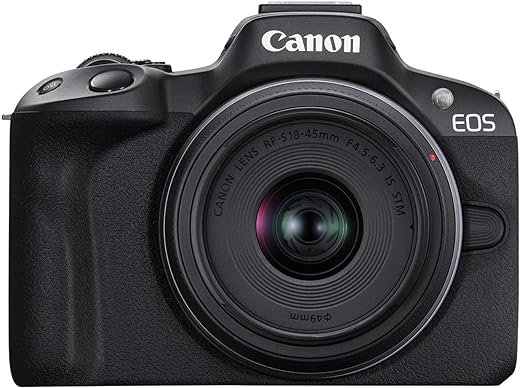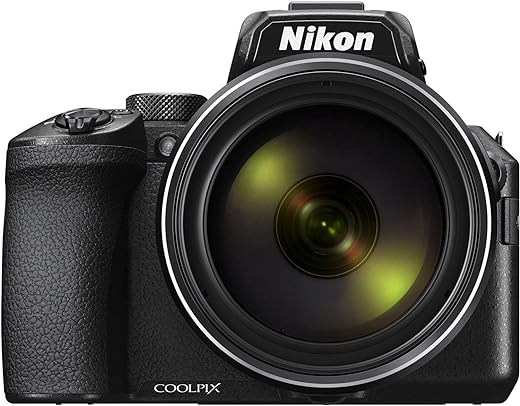When comparing the Canon EOS R8 and the Canon EOS R5, we are examining two powerful tools that cater to the needs of photographers and videographers alike. Both cameras offer cutting-edge technology and exceptional image quality, but each has its own strengths and features that make them stand out. Let’s delve into the details to help you choose the right camera for your creative pursuits.
Content Creation
The Canon EOS R8 is a compact and lightweight full-frame mirrorless camera, perfect for content creators. With a 24.2 MP sensor, 4K video capabilities, and advanced subject detection and tracking features, it offers high-quality imaging in a user-friendly package. Its impressive autofocus system and versatile movie recording options make it a great choice for vloggers, photographers, and videographers looking for professional-level performance.
Top Choice
The Canon EOS R5 Full-Frame Mirrorless Camera boasts a 45 Megapixel Full-Frame CMOS Sensor and DIGIC X Image Processor for high image quality and speed. With up to 12 fps mechanical shutter and 100% Dual Pixel CMOS AF coverage, it offers exceptional performance for both stills and video.
Canon EOS R8
Sensor Size
24.2 MP
Video Recording
4K at up to 60 fps
Autofocus
Dual Pixel CMOS AF II with 1,053 AF zones
Image Processor
DIGIC X Image Processor
Special Features
Subject Detection & Tracking, Compact, Lightweight
Canon EOS R5
Sensor Size
45 Megapixel
Video Recording
8K Video
Autofocus
Dual Pixel CMOS AF with 1,053 AF areas
Image Processor
DIGIC X Image Processor
Special Features
Dual Memory Card Slots, In-body Image Stabilizer, High Resolution Shot
Canon EOS R8
Canon EOS R5
Canon EOS R8
Canon EOS R5
Feature comparison chart
Canon EOS R8
| Feature | Details |
|---|---|
| Megapixels | 24.2 MP |
| Video Recording | 4K |
| Image Processor | DIGIC X |
| Autofocus | Subject Detection & Tracking |
| Connectivity | Smartphone Connection |
| Weight | Compact and Lightweight |
| User Type | Content Creator |
USPs:
- Compact and lightweight design
- Superior subject detection and tracking
- Ideal for content creators
- Seamless smartphone connectivity
Pros:
- Excellent autofocus capabilities
- Great for vlogging and content creation
- Lightweight and portable
- High-quality image and video output
Cons:
- Lower megapixel count compared to EOS R5
- Limited to 4K video recording
Use Cases:
- Vlogging
- Travel photography
- Social media content creation
Canon EOS R5
| Feature | Details |
|---|---|
| Megapixels | 45 MP |
| Video Recording | 8K |
| Image Processor | DIGIC X |
| Continuous Shooting | Up to 12 fps Mechanical Shutter |
USPs:
- High resolution 45 MP sensor
- Impressive 8K video recording capabilities
- High-speed continuous shooting
Pros:
- Advanced video recording features
- High-resolution images
- Fast continuous shooting
- Ideal for professional photographers
Cons:
- Heavier compared to EOS R8
- Higher price point
- Larger file sizes due to higher resolution and video capabilities
Use Cases:
- Professional photography
- Videography
- Studio work
Conclusive Assessment
The Canon EOS R8 is the ideal choice for content creators seeking a lightweight and versatile camera with excellent subject tracking and smartphone connectivity. On the other hand, the Canon EOS R5 caters more towards professional photographers and videographers who require high-resolution images and advanced video capabilities.
Final Summary
Choose the Canon EOS R8 if you prioritize portability, vlogging, and content creation. Opt for the Canon EOS R5 if you need top-tier resolution, video recording, and continuous shooting capabilities for professional photography and videography needs.
Comparing Canon EOS R8 and R5 Mirrorless Cameras
Comparing Canon EOS R8 and Canon EOS R5 Full-Frame Mirrorless Cameras
When deciding between the Canon EOS R8 and Canon EOS R5 Full-Frame Mirrorless Cameras, there are several key factors to consider to ensure you make the right choice for your photography needs. Below are some general guidelines and key points to help you compare these two excellent camera options:
1. Key Specifications:
- Canon EOS R8:
- Sensor Resolution
- Autofocus Points
- Continuous Shooting Speed
- ISO Range
- Video Recording Capabilities
- Canon EOS R5:
- Sensor Resolution
- Autofocus Points
- Continuous Shooting Speed
- ISO Range
- Video Recording Capabilities
2. Performance and Image Quality:
- Consider the image quality produced by each camera in different lighting conditions.
- Evaluate the performance of autofocus systems for fast and accurate focusing.
- Compare the dynamic range and low-light performance of both cameras.
3. Features and Functionality:
- Examine the available shooting modes and customization options.
- Assess the ergonomics and handling of the cameras for comfort during extended use.
- Look into the connectivity options such as Wi-Fi, Bluetooth, and USB.
4. Lens Compatibility and Accessories:
- Check the availability of compatible lenses and accessories for your specific photography needs.
- Consider the cost and availability of additional batteries, grips, and other accessories.
5. Price and Value for Money:
- Compare the price of both cameras and evaluate the features each offers for the cost.
- Consider the long-term value and potential for future upgrades or investments.
By considering these factors and guidelines, you can make an informed decision when comparing the Canon EOS R8 and Canon EOS R5 Full-Frame Mirrorless Cameras based on your photography preferences and requirements.
Comparing Canon EOS R8 and R5
The key differences between the Canon EOS R8 and Canon EOS R5 lie in several features:
- Sensor Resolution: The Canon EOS R5 boasts a higher sensor resolution of 45 megapixels compared to the 24.2 megapixels of the Canon EOS R8.
- Video Capability: The Canon EOS R5 is capable of shooting in 8K video resolution, while the Canon EOS R8 offers 4K video recording.
- Frame Rate: The Canon EOS R5 can shoot up to 20 fps in electronic shutter mode and 12 fps in mechanical shutter mode, whereas the Canon EOS R8’s frame rate specifications are not provided in the query.
These differences in sensor resolution, video capabilities, and frame rates could be important factors to consider based on your specific photography and videography needs.
Yes, the Canon EOS R5 does offer better video recording capabilities compared to the Canon EOS R8. The EOS R5 is capable of recording 8K video, has a higher resolution sensor, and features advanced video recording functions that surpass the capabilities of the EOS R8. If video recording is a priority for you, the EOS R5 would be the better choice between the two models.
The key differences between the Canon EOS R8 and Canon EOS R5 lie in their technical specifications and features.
The Canon EOS R8 features a 24.2 MP sensor with 4K video capabilities, subject detection, and tracking. It is designed to be compact, lightweight, and offers smartphone connectivity, making it ideal for content creators.
On the other hand, the Canon EOS R5 boasts a higher resolution with a 45-megapixel full-frame CMOS sensor, capable of shooting in stunning 8K video. It also includes the DIGIC X image processor and can shoot up to 12 frames per second with its mechanical shutter.
In summary, while the Canon EOS R8 is focused on being user-friendly and compact with its 24.2 MP sensor, the Canon EOS R5 is geared towards professional photographers and videographers who require higher resolution and advanced video capabilities.
The autofocus systems between the Canon EOS R8 and Canon EOS R5 differ in their capabilities. The Canon EOS R5 features a more advanced autofocus system compared to the Canon EOS R8. The EOS R5 boasts Dual Pixel CMOS AF II with 1053 autofocus points, which provides quick and accurate focusing performance across the frame. On the other hand, the EOS R8 likely has a slightly less advanced autofocus system with fewer autofocus points. In terms of autofocus performance, the Canon EOS R5 would be the preferred choice for users who prioritize precise and reliable autofocus tracking.
Yes, there are significant price differences between the Canon EOS R8 and Canon EOS R5. The Canon EOS R5, with its higher-end features like 8K video capability and a 45 Megapixel sensor, tends to be priced higher than the Canon EOS R8, which has 24.2 MP and 4K video recording. The pricing reflects the different specifications and capabilities of each camera model.














10 thoughts on “Canon EOS R8 vs Canon EOS R5”
I’m considering upgrading to one of these models, this article is very helpful.
I like how the article breaks down the specifications in an easy-to-understand manner.
The video recording capabilities seem impressive on both cameras.
Price is a big factor for many photographers, would be good to see a section on that.
I appreciate the detailed analysis of the autofocus systems.
It would be interesting to see a real-world performance comparison between the two cameras.
I own the EOS R5 and it has been a game-changer for my photography.
Dynamic range comparison would have been useful for landscape photographers.
Great comparison, helped me understand the key differences between the two cameras.
I wish there was more focus on low-light performance in the comparison.
Comments are closed.